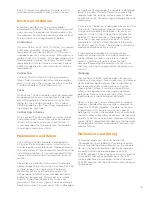
areas of the modules that have adhesive. Use a
soft clean roller to apply the force evenly across
the module. Hard or dirty rollers as well as dirty
modules may damage the modules top surface.
Figure 1 – Ensure proper gap between module pairs.
Figure 2 – Install wire trays between junction boxes.
1-5/8” GAP
Wire Tray Installation
The Sunflare raceway is designed to manage wire
runs and house module level power electronics,
such as optimizers or microinverters. The
raceway provides an aesthetic finish to your array
while protecting the wires and power electronics
from UV exposure.
There are four components to the raceway, the:
(1) bottom tray, (2) top cover, (3) coupler, and (4)
end cap. The tray is designed to fit between the
j-boxes of the module as shown in Figure 2.
The tray comes with adhesive already applied
along the bottom. Ensure proper alignment prior
to installation since removal and realignment
is very difficult after the adhesive touches the
laminate or the roofing. Clean dust, dirt, and oils
from the top of the modules and the roofing
prior to applying the tape. In most circumstances
soap and water is sufficient. If required, IPA can
be used to clean the module’s top surface. Follow
the roofing manufacturer’s instructions for cleaning
the roofing surface. Ensure all surfaces are dry and
meet the adhesive application temperatures of
40°F -120°F (4 °C to 49 °C). Failure to follow these
instructions could result in adhesive failure.
Butyl Adhesive
2-sided butyl adhesive is tape pre applied If
products come without the pre-applied tapes, it
can be field applied to the back side of the module
and the bottom of the tray. Only HelioBond PVA
600BT by HB Fuller has been approved for use
with Sunflare modules and wire trays. Do not use
any other adhesive. Doing so could void your
warranty and lead to product failures.
Install a 4” wide adhesive strip to the module and
tray prior to installing them on the roof. Clean the
adhesion areas to remove all oils and dirt. Ensure
the module and tray are between 40°F -120°F (4
°C to 49°C). Apply the tape along all edges of
the backside of the module and across the center
as shown in Figure 3. Ensure the tape makes a
complete seal all the way around the module to
keep water from penetrating under the module.
Apply the tape across the entire length of the
bottom of the wire tray.
7

































